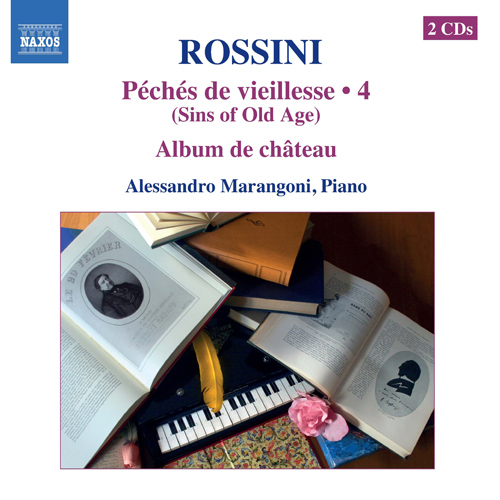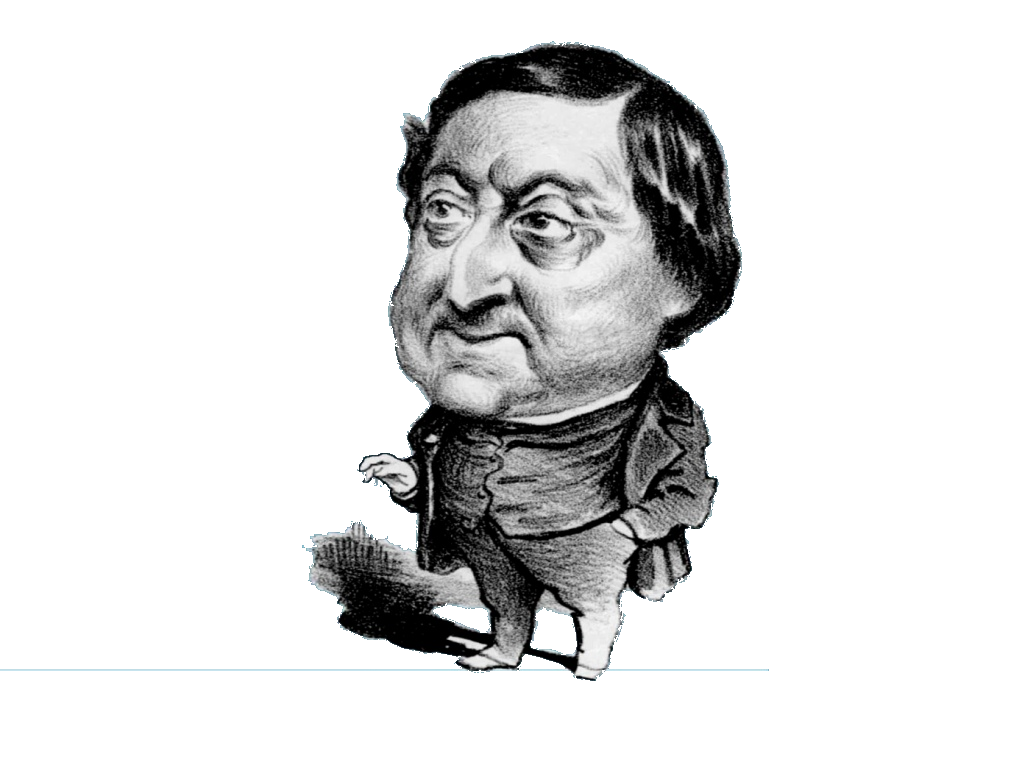 |
|
2 CD -
8.572608-09 - (p) & (c) 2012
|
|
| PÉCHÉS
DE VIEILLESSE - Volume 4 |
|
|
|
|
|
|
|
| Gioachino ROSSINI
(1791-1868) |
Péchés
de vieillesse - Volume VIII "Album de
chateau"
|
|
|
|
|
-
No. 1 - Spécimen de l'ancien régime
|
|
17' 41" |
CD1 - 1 |
|
-
No. 2 - Prélude pétulant-rococo |
|
7' 21" |
CD1 - 2 |
|
-
No. 3a - Un regret - |
|
3' 07" |
CD1 - 3 |
|
- No. 3b - Un espoir |
|
4' 14" |
CD1 - 4 |
|
- No. 4 - Boléro tartare
|
|
10' 11" |
CD1 - 5 |
|
- No. 5 - Prélude
prétentieux
|
|
5' 22" |
CD1 - 6 |
|
- No. 6 - Spécimen de
mon temps
|
|
12' 59" |
CD1 - 7 |
|
- No. 7 - Valse
anti-dansante
|
|
7' 44" |
CD1 - 8 |
|
Péchés de vieillesse
- Volume IX "Album pour piano, violon,
violoncelle, harmonium et cor" |
|
|
|
|
- No. 9 - Prélude
Italien |
|
7' 01" |
CD1 - 9 |
|
- No. 12 - Petite
fanfare à quatre mains |
|
3' 52" |
CD1 - 10 |
|
Péchés de vieillesse
- Volume VIII "Album de chateau" |
|
|
|
|
- No. 8 - Prélude
semipastorale
|
|
14' 56" |
CD2 - 1 |
|
- No. 9 - Tarantelle pur
sang (avec Traversée de la procession)
|
|
10' 45" |
CD2 - 2 |
|
- No. 10 - Un rêve |
|
9' 27" |
CD2 - 3 |
|
- No. 11 - Prélude
soi-distant dramatique |
|
11' 32" |
CD2 - 4 |
|
- No. 12 - Spécimen de
l'avenir |
|
10' 22" |
CD2 - 5 |
|
Péchés de vieillesse
- Volume IX "Album pour piano, violon,
violoncelle, harmonium et cor" |
|
|
|
|
- No. 6 - Echantillon du
chant de Noël à l'Italienne
|
|
6' 56" |
CD2 - 6 |
|
- No. 7 - Marche et
réminiscences pour mon dernier voyage |
|
8' 16" |
CD2 - 7 |
|
- No. 11 - Echantillon
de blaguemélodique sur les noires de la
main droite |
|
7' 43" |
CD2 - 8 |
|
|
|
|
|
Alessandro MARANGONI, pianoforte
Stenway & Sons
|
|
|
|
|
|
Luogo
e data di registrazione |
|
Baroque
Hall, Ivrea, Torino (Italia) - 18-19
marzo & 15-17 giugno 2010 |
|
|
Registrazione:
live / studio
|
|
studio |
|
|
Producers |
|
Renato
Campajola & Mario Bertodo (SMC
Records) |
|
|
Recording
engineers |
|
Renato Campajola
& Mario Bertodo (SMC Records)
|
|
|
Editors |
|
Renato
Campajola & Mario Bertodo (SMC
Records) |
|
|
Cover |
|
Paolo
Zeccara |
|
|
Edizione
CD |
|
NAXOS |
8.572608-09 | (2 CD) | durata 2h 39'
27" | (p) & (c) 2012 | DDD |
|
|
Note |
|
-
|
|
|
|
|
Gioachino
Antonio Rossini, one of the most
successful and popular operatic
composers of his time, was born
in Pesaro in 1792, five months
after the marriage of his
parents. His father, a
brass-player and later teacher
of the French horn at the
Bologna Accademia, had a modest
career, disturbed by the
political changes of the period
as the French replaced the
Austrians in Northern Italy.
Rossini’s mother was a singer
and as a boy Rossini made his
appearance with his father in
the pit orchestra and from time
to time as a singer with his
mother on stage, going on to
work as a keyboard-player in the
opera orchestra.
Rossini’s early studies in music
were with his father and mother,
and with other teachers through
the generosity of rich patrons.
In childhood he had already
started to show ability as a
composer and his experience in
the opera-house bore natural
fruit in a remarkable and
meteoric career that began in
1810 with the production of La
cambiale di matrimonio in
Venice.
There followed a series of
operas, comic and tragic, until
the relatively poor reception of
Semiramide in Venice in
1823 turned Rossini’s attention
to Paris. Under the Bourbon King
Charles X Rossini staged French
versions of earlier works and in
1829 Guillaume Tell. A
contract for further operas came
to nothing when the King was
replaced in the revolution of
1830 by Louis-Philippe, although
eventually, after some six
years, Rossini was able to have
his agreed annuity restored.
With matters settled in France,
in 1836 he returned to Italy and
in spite of ill health concerned
himself with the affairs of the
Liceo Musicale in Bologna. The
revolutionary disturbances there
in 1848, activities with which
he had little sympathy, seemed
to threaten him and his second
wife, Olympe Pélissier, whom he
had married in 1846, after the
death of his first wife, the
singer Isabella Colbran, from
whom he had been legally
separated since 1837. For his
own safety he moved first to
Florence, but in 1855, partly in
a search for better health,
returned to Paris. In that city
and a few years later at his new
villa at Passy he passed the
rest of his life.
Rossini’s last ten years brought
a return to composition,
principally with a series of
pieces described as Péchés
de vieillesse (Sins of Old
Age). Some of these are based on
earlier works, some designed for
performance at the informal
Saturday evenings when he
entertained guests in Paris, and
others simply musical obiter
dicta, as it were, pieces
written as the mood took him.
The Péchés de vieillesse
are included in thirteen
volumes, with the fourth to the
eighth grouped together by
Rossini as ‘Un peu de tout.
Recueil de 56 morceaux
semicomiques pour le piano
(“Je dédie ces Péchés de
vieillesse aux pianistes de la
4.me classe à la quelle j’ai
l’honneur d’appartenir”)
(A little of everything.
Collection of 56 semi-comic
pieces for the piano: “I
dedicate these Sins of Old Age
to pianists of the fourth class,
to which I have the honour to
belong”). Rossini was unfairly
modest about his abilities as a
pianist, which were, it seems,
not inconsiderable. Other
volumes also contain piano
pieces.
The eighth volume of the Péchés
de vieillesse has the
title Album de château.
It contains twelve pieces,
coupled here with five piano
pieces from Volume IX. The set
starts with Spécimen de
l’ancien régime, which
includes a characteristic waltz
and a reminiscence of Bach in a
fugal section. The following Prélude
pétulant-rococo fulfils
the promise of its title with
its lively parody of rococo
ornament, use of sequence,
repeated notes and, not quite in
character, its surprising
conclusion. Un regret and Un
espoir (A Hope) offer
suitable contrast, the second
piece including a returning
lyrical operatic interlude.
Other elements find their way
into the promised dance in Boléro
tartare, followed by an
ostentatious display of fugal
counterpoint, replete with final
stretto and coda in Prélude
prétentieux. Spécimen
de mon temps takes a wrily
affectionate look at some
contemporary operatic fashions,
opening with a stolid Andantino
maestoso before venturing
into more dangerous territory,
and the Valse anti-dansante
offers a terpsichorean warning.
Prélude italien and Petite
fanfare are from Volume
IX, which includes some pieces
for violin, cello, harmonium and
horn, as well as works for
piano. The Petite fanfare
is given in a version for piano
either two or four hands.
Prélude semipastorale
explores key after key in its
very ornamental progress. It is
followed by Tarantelle pur
sang (avec Traversée de
la procession)
(Thoroughbred Tarantelle (with
the crossing of the
procession)). There is an
introduction, before the dance
takes up its characteristic
rhythm. The bell announcing the
procession, with its
accompanying hymn, interrupts
the tarantella, which soon
resumes its headlong course. The
procession is heard once more,
and the music of the
introduction, followed by the
return of the tarantella. There
is also a suggested version of
the piece for chorus, harmonium
and handbell.
Un rêve (A Dream) has all
the variety that its title
suggests, including a nightmare
episode and a passage suggesting
the sound of horns. Prélude
soi-disant dramatique
(So-called Dramatic Prelude)
opens with sinister intensity,
before moving to more lyrical
operatic material, including a
staged march and adventurous
modulations. Spécimen de
l’avenir (Specimen of the
Future) suggests a satirical
view of Liszt’s music of the
future, going nowhere in
particular, in spite of
everything.
Echantillon du chant de Noël
à l’italienne (Example of
the Christmas Carol in Italian
Style) offers the characteristic
gentle lilt of the Christmas
song, interspersed with the
bagpipes of the shepherds, a
piece taken from Volume IX, as
are the final two pieces
included here. Marche et
réminiscences pour mon dernier
voyage (March and
Reminiscences for My Final
Journey) frames brief excerpts
from a number of Rossini’s
operas within a funeral march—frappons
(let us knock), Rossini urges. Di
tanti palpiti from Tancredi
is followed by Non più mesta
from Cenerentola, a
fragment of La donna del
lago, a quotation from the
overture to Semiramide,
a familiar rapid reference to Guillaume
Tell, and the Gondolier’s
song Nessun maggior
dolore from Otello,
recalling Dante’s narrative of
Paolo and Francesca. The last
reminiscence is of Il
barbiere di Siviglia, a
fragment of the Goodnight
Quintet, in which Don
Basilio is urged away,
apparently in need of a doctor,
Buona sera, mio signore.
As the composer nears the gates
of Heaven there follows Mon
portrait – allons (Let’s go) –
j’y suis (I am there) –
and a final bar, Requiem.
The present recording ends on a
lighter note with Echantillon
de blague mélodique sur
les noires de la main
droite (Example of a melodic
joke on the black notes of the
right hand), its G flat major
melody designated Chant
cochon by the composer.
Keith Anderson
|
|

